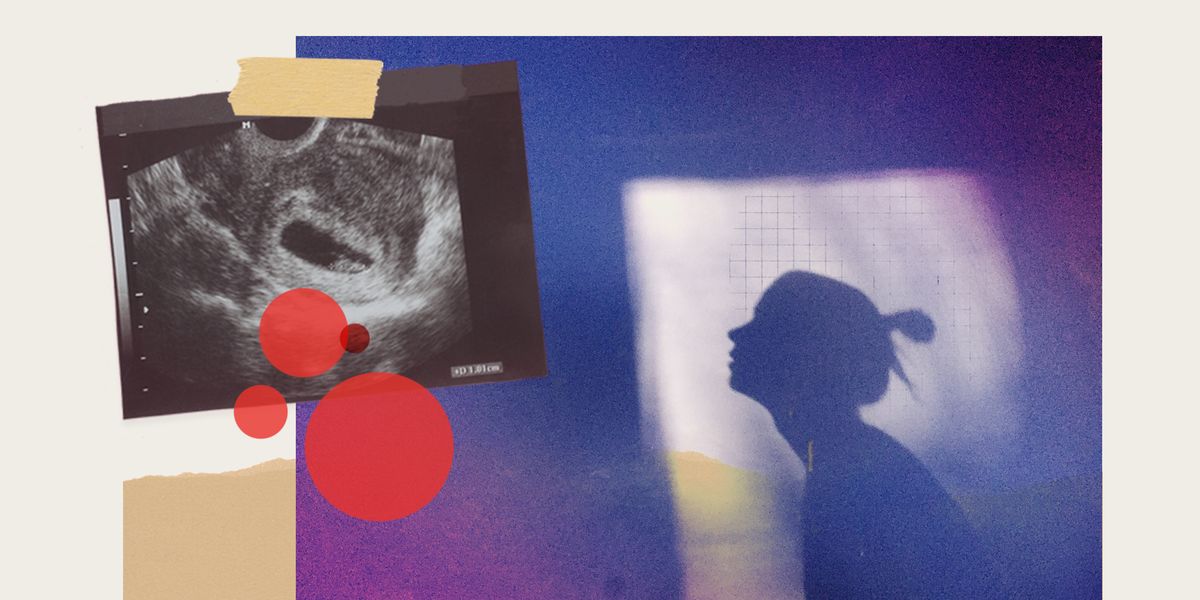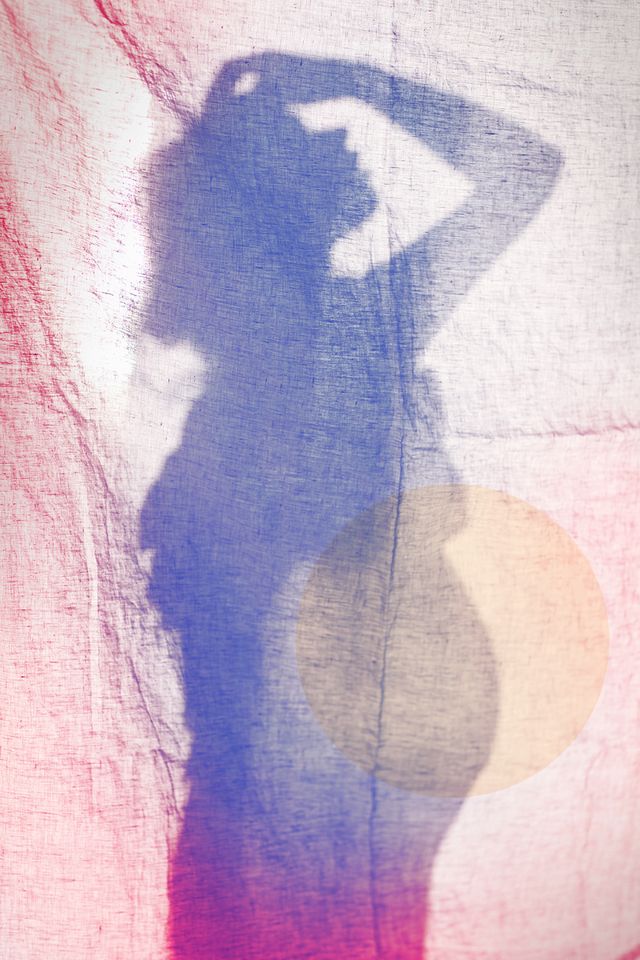I didn’t think I could have a baby, but then I got pregnant by a fluke.
It was my first time in bed with the man I called Frenchie, and maybe I wasn’t being all that cautious, but I’d like to chalk it up to getting lost in translation. Even though I grew up in a French-speaking home, my language skills are more akin to “I’ll take the bus home from school today” and less “I’m ovulating.” Frenchie, known to others as Lio, was shocked to learn that I didn’t know the French word for “orgasm,” but that wasn’t exactly the kind of topic my father was interested in discussing around the dinner table.
I was 38 when the pregnancy test I took alone on a cloudy Monday morning in between Zoom meetings came back positive. I was pregnant in spite of the fact that I took the morning-after pill. I was pregnant, though I have a split uterus; the scar tissue I was born with cleaving my uterus in two. I was pregnant, though I have a chronic illness and the fistfuls of medication I take are, according to my many doctors, “incompatible with pregnancy.” I was pregnant in spite of the fact that I was pushing 40 and told a man I’d just met, and who I actually liked, that “I can’t have children.”
I drank a bottle of wine and inhaled three cigarettes in front of Frenchie before breaking the news. “Lio. I’m pregnant. It’s yours,” I slurred, watching as every drop of blood drained from, in my estimation, one of the most beautiful faces around. When two minutes of silence turned into 10, I collapsed into the shoulders I’d only known for three weeks.
We’d spent those first few weeks together blissed out—dancing to old records on the tiny patch of open floor in my living room, eating dinner with our hands at midnight, falling into bed at 4 A.M., and not getting out of it ‘till noon. Everything together was new and fresh. Our first trip to the grocery store just to buy a watermelon was thrilling, even if the fruit was mealy. I didn’t care who saw us rolling around in the park that afternoon; his skin smelled so good in the bright green grass under the sun.
Once Lio recovered from the shock of the pregnancy, he released me from his arms and started to open up. “When you told me the night we met that you couldn’t have children, I was sad,” he said in his thick Gallic lilt. “I want to have another family, and I like you.” Lio had a daughter, and I figured someone separated and with a daughter wanted their freedom. I figured dating someone with a chronic illness would be prison enough. It had been for me, after all.
I was diagnosed with ulcerative colitis, a chronic illness of the gut, at 35, three years before I met Lio. The illness came on fiercely and with a quickness. In January of that year, I was healthy, had just gotten a promotion, and was seeing a few different men with the hope of forming a real connection. A family girl at heart, I knew I wanted one of my own. But by February, I was in the hospital, tethered to the commode, and suffering from painful bowel movements 30 to 40 times a day. Months of gut-wrenching vomiting and bloody diarrhea don’t leave much of an appetite for dating, much less relationships. How was I supposed to meet someone, plan for, and take care of a baby when I was too sick to feed my cat?
During those early months of my illness, there were times when, according to my phone, I took about 250 steps in a day—which amounts to 25 trips to the bathroom. Those days, there was no pleasure in reading, no satisfaction in a crossword puzzle, no reality television show trashy enough to transport me out of my interminable pain. Some of the more sensitive men in my contact list offered to come visit, but the gnawing pain throbbing through every inch of my body severed any ability to speak, let alone flirt.
In between the debilitating illness flare-ups, I ventured out into the world. But I got nervous when the dates escalated to “let’s go on a hike.” At this point, we’d done time within the safety of my home, and my illness hadn’t yet betrayed itself. “But you don’t look sick,” they’d tell me. They couldn’t see it from the outside, but I was weak from my bodily war games. So, no, I didn’t want to huff and puff up a hill, taking breaks every few minutes in front of someone new I was trying to impress. Instead, I’d cancel—again.
I started picking men who I knew I’d have no trouble leaving, men who didn’t cause a whole lot of trouble when they left me. But with Lio, it was different. I didn’t want to confine him to a once-a-week time slot. I longed to wake up next to him, toilet emergencies be damned. It also helped that around the time we met, I was on enough steroids to keep many of my symptoms at bay. So long as I kept diligently taking my meds, Lio wouldn’t see me writhing in pain. He wouldn’t see me unable to control my bowels with blood clots dripping down my legs, the ones he’d only known as a place to caress.
But now I was pregnant and unsure what I wanted to do. In the meantime, my doctors tapered me off the steroids that had given me my life back. It could cause complications, they told me, and I was high-risk enough. But pregnancy hormones are known to cause problems for some women with chronic illnesses, and without steroids by my side, what would happen if I was too sick to eat for weeks on end? What would happen to the fetus growing inside me once I started throwing up water?
While I wavered, Lio and I fast-tracked our relationship with some big talks. Does he want another child? Do we want to be parents, together? What happens if he decides to quit Los Angeles and move back to France? A few weeks prior, I had no idea this man even existed, but now I couldn’t get him out of my brain. And I didn’t want to. Lio told me that whatever decision I made about the pregnancy, he would stay by my side. In between our very serious talks, we took our clothes off. Repeatedly.
While I was falling in love with this man, I started to fall in love with the idea of seeing the pregnancy through to the end. After years of being sick and with the odds stacked against me, I had given up on the idea of having a child. But now I was feeling good in my body. This felt like my last shot, and I wanted to take it.
But my body had other ideas.
It took only a few weeks without steroids for the little clump of cells on my uterine wall to rob me of my newfound health. What started as a drop of blood on some toilet paper quickly morphed into a full-on flare. Out was dancing on the tiny patch of floor in my living room; in was throwing up water. Out were adult talks where we toyed with the idea of a future; in were adult diapers. Out was moaning from pleasure; in was moaning from pain. I began to worry that if I was tethered to the toilet for months on end, I might scare this person away. I was scared that I might call it quits before he ever had the chance to leave me. I also knew I couldn’t endure nine months of pain so thick you can’t see straight. I knew I couldn’t care for a newborn from the bathroom floor, a newborn I wasn’t even sure could materialize through the fog of illness.
And so, I booked the appointment. It was a sunny Thursday morning when I arrived at the abortion clinic alone. COVID protocols didn’t allow for a plus one. I was greeted by an elderly anti-choice activist armed with pamphlets covered in blood-soaked fetuses. I greeted him back with two middle fingers. I changed into a paper gown and sat shivering in the overly air-conditioned waiting room for four hours, sometimes chatting with the other girls, alone and also shivering, beside me. One already had a one-year-old and had barely gotten over the difficult birth. Another had eight children and wanted a ninth, but not right now. Another, a teenager, bobbed along to music on her headphones, just audible under her pink bedazzled hoodie. We all took turns getting our fingers pricked, getting the ultrasound no one wanted.
When they called my name and ushered me into the operating room, I was surprised by the sparseness of it all. Just a short blue table covered in thin white paper with vintage leather stirrups hanging from metal arms. No pillow, no blanket for the cold. Nothing like the plush gastroenterologist’s table I was used to at my Pasadena hospital. The doctor was young, maybe my age, and she inserted the IV into my flat veins on only the second try. “A pro,” I remember thinking as I felt the anesthesia hit, burning each millimeter as it snaked its way up my arm.
I woke up in the recovery room to a sea of hospital beds cradling passed-out women of all ages and sizes. High on pain medication and full of cramps, I watched as a nurse’s assistant fixed a diaper to my adult hips. “How’d I do?” I slurred. Maybe she didn’t hear me, but she never answered, and in the end, I didn’t need her reassurance. It was more important for me to be a healthy human than it was for me to be a mother. As she kept on with her business of pushing down on my uterus, I felt nothing but intense relief that I had chosen me.
While I laid there for the 10 minutes I was allotted to recover from the procedure, I remembered something that happened to me when I was 16. I’d gone over to my boyfriend’s house after school, because he had the ultimate luxury: cable television. His mother came home to find us in his bedroom with the door shut. She burst into the room, accused us of having sex, and screamed repeatedly into my teenage face: “Getting an abortion will ruin your life!” No matter that we were fully clothed and watching MTV.
It’s been nearly two years since my procedure, and since then the Supreme Court has overturned Roe v. Wade. Could I have gotten the procedure today? Yes, because thankfully I live in California. But millions of women with chronic illnesses, who live in states where abortion is now banned, won’t be so lucky. They could be forced to carry a painful and potentially life-threatening pregnancy to term.
Lio and I are currently living together with my cat and his five-year-old daughter. The living room is wide, and the dance parties are legendary. Getting an abortion didn’t ruin my life. It allowed me to keep on living it.
Stephanie Atlan is the communications director at SCI-Arc in Los Angeles. She was diagnosed with ulcerative colitis in 2018. She’s received four fecal transplants, one via endoscopy, so technically, she has eaten shit.


